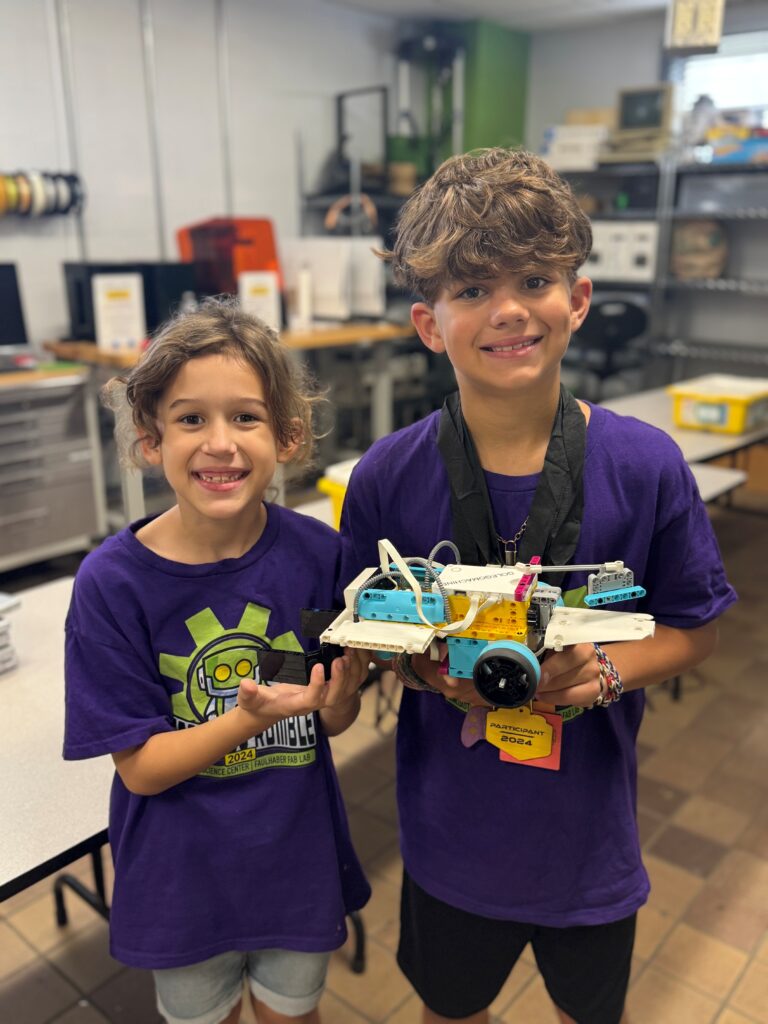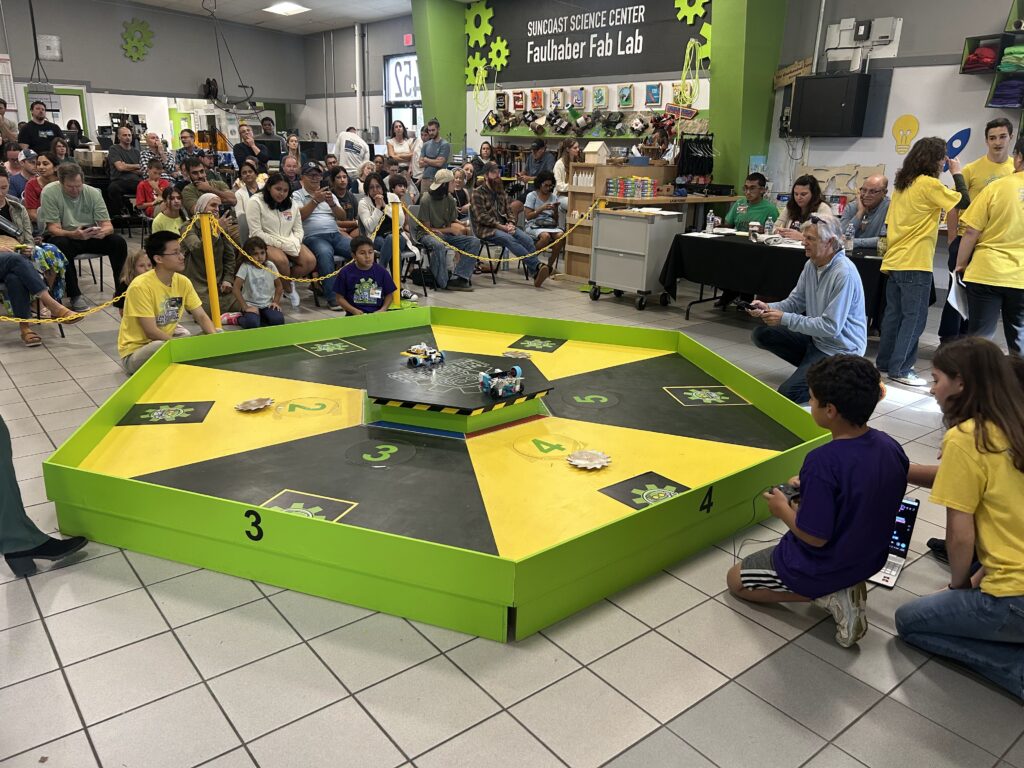PEP students flock to Sarasota's Fab Lab, where STEAM learning is fueled by their imagination
SARASOTA – Duct taped to the wall of Eliah Hillebrand’s bedroom, next to the light switch, is the engine from one of his remote-controlled cars. Attached to that is a small, arm-like device. Using the remote, the 11-year-old can turn the ceiling light on or off from his bed.
“Genius,” said Eliah’s mom, Jennifer. “I don’t know how he even thought to do that, but I definitely would credit Fab Lab.”

Fab Lab is the Suncoast Science Center/Faulhaber Fab Lab in Sarasota. It is a haven for students engrossed in all things STEAM.
If you are stimulated by science, tickled by technology, energized by engineering, mad for mathematics, or if art is your jam, you are among your people at Fab Lab.
A Florida education choice scholarship can help get you there.
The place has everything one needs to create nearly anything one can imagine.
“Any technical skill you can think of you can probably do it here,” Jenn Sams Scott, Fab Lab’s marketing and communications director, said.
There are screws, nuts, bolts, nails, and electrical wire.
There are saws, grinders, sanders, and routers. Laser cutters, 3D printers, and a Computer Numerical Control (CNC) mill that’s as big as the chassis of a small car.
Students from grades K-12 attend after-school and Saturday workshops during the school year, and camps during the summer.

They build remote-controlled cars and participate in “car wars.” The RC cars race around a course filled with obstacles. The last race had a dinosaur theme, which meant the cars had to dodge a moving dinosaur tail and a volcano spewing lava. The winning car earns a place of honor on a wall of fame.
They construct robots for the equally popular Lego RoboRumble. There, robots force each other out of the ring. The winner is the last robot standing.
Hanging from the ceiling are rockets built by the members of the Rocketry Club, including one that soared 6,400 feet.
There are STEMinars for leather artistry, timber and blade, and steel ideas.
There’s a Gardenpalooza and a Halloween workshop where participants laser-etch designs on pumpkins. There’s also a workshop to laser-etch designs on pumpkin pies.
“There are a lot of interesting things happening there,” said Elisa Rothbloom, whose two sons use their Personal Education Program (PEP) scholarships to attend Fab Lab’s Lego Robotic camp. PEP, which is funded by corporate donations through the Florida Tax Credit Scholarship program and managed by Step Up For Students, is available for K-12 students who aren’t enrolled full-time in a public or private school.
PEP scholarships can now be used for STEAM Saturday classes, and Sams Scott is hopeful RoboRumble will soon be available under the scholarship. Both programs are scheduled to begin in October.
Sams Scott said enrollment has increased since the advent of the PEP scholarship for the 2023-24 school year.
“It’s been crazy,” she said. “At least 10% of the participants are on PEP, and it’s growing.”

Eliah and his younger sister, Ellah, 8, are among the growing group of PEP students who use the scholarship to pay for Fab Lab’s camps and classes.
Together, Eliah and Ellah built a Lego robot they named Chungus, after the Minecraft character. They finished third in the RoboRumble’s fourth-to-sixth-grade division.
“We keep things pretty simple—mostly pen and paper, very little online. Even so, they worked so hard and came in third place, competing alongside kids with much more technology experience,” Jennifer said. “It was amazing to see how they took what they knew, learned from Fab Lab, and really ran with it. I’m so proud of them.”
Fab Lab opens a new world for students like Eliah, who, according to his mom, “likes to tinker.”
“I like how they teach me how to invent things,” Eliah said.
Like a remote control to turn off his bedroom lights.
“I just wanted to invent something fun,” he said.
While the word “fun” is not in Fab Lab’s name, it could be.
“They don’t realize they’re learning because they’re having so much fun,” Sams Scott said while giving a visitor a tour of the building on a recent morning, while camps were in session.
She had to raise her voice to be heard over the steady whack, whack, whack coming from a classroom, where the second- and third-graders attending the Little Builders camp were learning how to pound nails into a piece of wood.
The campers were supervised by high school students, who volunteer their time and share their knowledge. That’s a unique setup that parents enjoy. It seems their children are eager to work with the high-schoolers, who they see as role models.
“It’s incredible that high school students are creating and leading these programs,” said Holly Atkins, whose son Ethan, 11, and daughter Ella, 8, receive the PEP scholarship and have attended Fab Lab for the past two years. “They really connect with the younger kids.”


At home, Holly said her children complete their core classes — reading, math, and writing.
“Then we look for activities that spark their curiosity, that light them up,” she said. “Fab Lab checks that box.”
Ella gravitates toward hands-on experiments, food science, and crafts, while Ethan is drawn to science and engineering. Recently, he joined a four-member team that designed, built, and raced a remote-controlled car. The project required collaboration from start to finish: choosing a theme, designing the car, creating a presentation board, and fielding questions from a panel of judges.
The team ultimately placed second in design.
“They had to practice communication, teamwork, and leadership skills,” Holly said. “Ethan was learning all of that and having a blast at the same time.”
Sams Scott said one reason why Fab Lab is so popular is that it’s not a school.
Fab Lab is a learning center where students don’t have to worry about grades. Trial and error are great teachers. What might not have worked on one project might be just what’s needed for another.
There is success in every room, at every workstation.
A big win for some students came the day a local automation company visited Fab Lab with a robotic arm used in the assembly process. The students programmed it to hold a squeegee and clean a window. They were told that if they wanted to use the robot for its intended purpose, they would need to learn a certain computer-aided design (CAD) program.
“They have,” Sams Scott said. “It’s a program they learned here that they use here.”
Roger Mooney, manager, communications, can be reached at [email protected].
